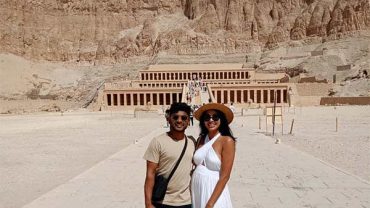Nestled in the heart of Luxor, Egypt, the Habu Temple stands as an ancient testament to the grandeur of Pharaonic architecture. Dedicated to the falcon-headed god Amun, this remarkable structure dates back to the 13th century BCE and serves as a mesmerizing portal into the rich history of the New Kingdom period. As you step into its hallowed grounds, the sheer scale of the temple’s imposing walls and towering pillars evokes a sense of awe, transporting visitors to a bygone era where reverence for deities and the artistry of construction were intertwined. Let’s embark on a journey through the key facets of this historical gem.
Architectural Marvels
The architecture of Habu Temple is a harmonious fusion of precision and artistry. Massive sandstone walls adorned with intricate reliefs tell tales of battles, triumphs, and the religious rituals of ancient Egypt. The Great Hypostyle Hall, with its forest of colossal columns, immediately captures attention. These pillars, meticulously adorned with hieroglyphs and vibrant paintings, showcase the craftsmanship that defined this era. As sunlight filters through the pillars, casting a warm glow on the scenes depicted, it becomes apparent that every inch of the temple was a canvas for storytelling. The precision in alignment, the symbolism in each carving, and the sheer scale of the complex paint a vivid picture of the societal and religious significance attached to Habu Temple.
The sprawling courtyards, flanked by statues of pharaohs and gods, provide a glimpse into the grand processions and ceremonies that once took place here. The attention to detail is not just in the grandeur but also in the functional aspects of the temple, with well-designed chambers and chambers serving specific religious and administrative purposes. As visitors navigate the labyrinthine corridors, the architectural prowess of the ancient builders becomes increasingly evident. It’s a living testament to a civilization that understood the importance of blending aesthetics with functionality, leaving an indelible mark on the landscape of Luxor.
Religious Significance
Beyond its architectural splendor, Habu Temple is a spiritual sanctuary, steeped in religious significance. Dedicated primarily to Amun, the king of the gods, the temple also honors other deities such as Montu and Mut. Each chamber and hallway is a testament to the religious rituals and ceremonies that once echoed through these sacred walls. The Sanctuary of Amun, nestled deep within the temple, served as the holiest space, where only the highest priests were allowed. The walls, adorned with depictions of the pharaoh in divine communion, highlight the divine authority bestowed upon the ruler.
The rituals performed within these hallowed halls were not merely ceremonial; they were believed to maintain cosmic order. The symbiotic relationship between the pharaohs and the gods is intricately woven into the fabric of the temple’s design. As visitors stand in the sacred spaces, they can almost feel the echoes of chants and prayers that once reverberated, creating a palpable connection to the spiritual tapestry of ancient Egyptian beliefs. Habu Temple, in all its grandeur, stands as a bridge between the earthly and the divine, inviting modern visitors to witness and appreciate the profound spirituality that shaped the lives of the ancient Egyptians.
Artistic Riches
The walls of Habu Temple unfold an artistic panorama, showcasing the mastery of ancient Egyptian craftsmen. Hieroglyphs, paintings, and bas-reliefs depict not only historical events but also the daily life and cultural nuances of the time. Scenes of triumphant pharaohs, divine offerings, and mythical tales grace the surfaces, creating a visual symphony that encapsulates the vibrancy of ancient Egyptian culture. The colors, though faded by time, still whisper the stories of a civilization that revered art as a powerful means of expression.
The decorative elements extend beyond the grand halls to the smaller chambers, where the intricate details often escape casual glances. Every symbol, every stroke, carries a significance that adds layers to the narrative etched into the stones. The attention to detail extends to the statues that guard the temple, their serene faces and regal postures speaking volumes about the reverence bestowed upon the deities they represent. It’s a testament to the Egyptians’ belief that art was not just an embellishment but a conduit to connect with the divine, a philosophy that infused life into every corner of Habu Temple.
Ongoing Preservation Efforts
Preserving the legacy of Habu Temple is a task as monumental as the structure itself. In recent years, concerted efforts have been made to safeguard this historical treasure for future generations. Restoration projects, employing a delicate balance of modern conservation techniques and traditional craftsmanship, aim to arrest the decay caused by centuries of exposure to the elements. The meticulous work of archaeologists and preservationists ensures that the stories engraved on the walls continue to captivate audiences for years to come.




Comment (0)